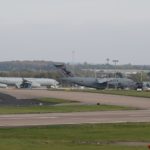Over the next three years, the RAF’s Typhoon aircraft will develop into very capable multi-role fighter. Today, it is the RAF’s premier fighter, tasked to defend British skies. But, by April 2019, when the RAF Tornado retires, the Typhoon will be expected to fulfil its air-to-ground capabilities as well. Alan Warnes reports.
Both the Tornado and the Typhoon are currently involved in Operation Shader, the UK’s contribution to bombing Daesh targets in Iraq and Syria out of RAF Akrotiri (Cyprus).
There are five operational Typhoon squadrons, which share responsibilities for Shader and also include three quick-reaction alert (QRA) interception roles at RAF Lossiemouth, Scotland; RAF Coningsby, Lincs; and RAF Stanley, Falkland Islands.
That’s quite a tall order for such a small force.
However, the November 2015 strategic defence and security review (SDSR) signalled more growth for the Typhoon force, leading to the establishment of three additional squadrons by the end of 2019. It came after the MoD recognised the RAF didn’t have enough squadrons to fulfil its overall mission.
Air Commodore Ian Duguid, the Typhoon force commander said: “We had a compelling case to grow more combat power as quickly as we could but the only way of doing that was effectively halting the withdrawal of all 48 tranche 1 Typhoons and extending their service life. That was confirmed in the SDSR – but we are still planning to take some elements out of service.”
As the RAF moves to a single-seat Typhoon force, so the need for two-seat aircraft will diminish. It will have some, but the majority of the two-seaters are tranche 1s, which will be taken out of service.
Another reason for reducing the number of tranche 1s is the 10-year Typhoon total availability enterprise (TyTAN) agreement, announced by BAE Systems at the Farnborough International Airshow, which is worth £2.1 billion over the lifetime of the contract.
“TyTAN includes an element for long-term support, where we need to harvest some of the older tranche 1 aircraft for spares,” explained Duguid. “Using the spare parts or ‘reducing to produce’ as we know it, is a recognised process that the Tornados have been going through for a few years now.
“The tranche 1s will remain in service life until 2035; whereas the modern tranche 2/3s will stay until 2040. We are now working through some higher level planning to determine where the tranche 1s will be based and the additional squadrons’ number plates. The aim is to have their capability available by mid-to-late 2019.”
Under Project Centurion, the RAF’s Typhoon contracted upgrade requirements will be completed by the end of 2018. It will include integration on to tranche 2/3 jets of the Storm Shadow cruise missile, Meteor beyond-visual-range air-to-air missile, and Brimstone 2 weapon.
Those jets will cover the multirole requirements, working with the F-35 Lightning IIs when they arrive in the UK in mid-2018, knitting the RAF’s future combat air capability together.
Duguid added: “Currently the only difference between the Typhoons is that tranche 1 are cleared to carry the 1,000lb Enhanced Paveway II precision-guided munition (PGM), whereas tranche 2 carries the 500lb Paveway IV PGM. The latter is a more modern, more versatile bomb, which we are using in the Middle East against Daesh.
“However once Project Centurion is delivered, it will create a difference in capabilities – a more significant difference than that which currently exists between tranche 1 and tranche 2/3 aircraft.”
Continuing to operate the older tranche 1s will enable the RAF to cover Red Air (aggressor) and air defence roles. They could also contribute to the new operational training requirement known as air support to defence operational training (ASDOT), which may be outsourced to a civilian contractor by 2019.
Duguid said: “It won’t only be the tranche 1 squadrons which will contribute to ASDOT, although potentially they will have a more significant role – they will be part of the frontline squadrons we have. But they will be directed more towards air defence than undertaking a wider multirole capability.”
Four II(AC) Squadron Typhoons manned a NATO quick reaction alert station at Amari Air Base in Estonia from May 1 to August 31, 2016. They were responsible for Baltic air policing as part of Operation Azotize, and were launched 21 times to intercept unidentified aircraft, mostly Russian.
The RAF sent eight Typhoons to Nellis AFB, Nevada, for Exercise Red Flag in mid-January, in what is now a regular occurrence.

